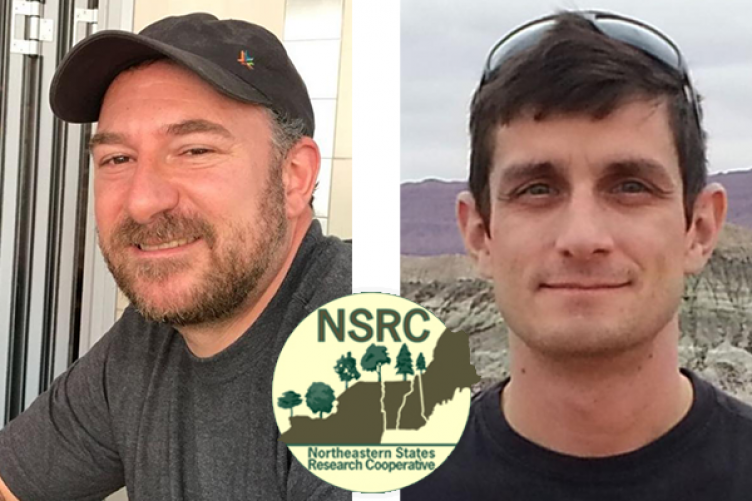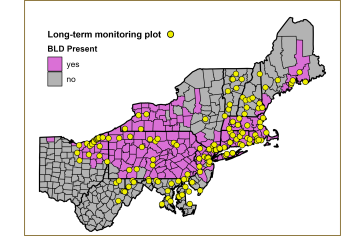
UNH Forestry researchers Jeff Garnas (left) and Matthew Vadeboncoeur are both leading projects recently funded by grants from the Northeastern States Research Cooperative.
What impact do nonnative pests and diseases have on the vegetation of the Northern Forest? How will climate change impact the range of the northern red oak, especially within the Northern Forest?
These are two questions that University of New Hampshire scientists hope to answer with support from the U.S. Forest Service-funded Northeastern States Research Cooperative (NSRC) competitive grants program. Recently, the NRSC announced $2 million of federal funding and nearly $1.1 million in matching funds for 12 research projects focused on the Northern Forest, which refers to the 26-plus million acres of forested land stretching across Maine, New Hampshire, Vermont and into New York.
“Our forests play an important role in our local economy, in the overall health of our environment, and as a major resource in combating the effects of climate change,” noted Senator Jeanne Shaheen (D-NH). “Our policies to address these critical issues depend on sound science, which is built on this type of research. I applaud the NSRC, their member institutions and all the researchers who do the hard work on these critical studies.”
Invasive Pest Effects on Tree Demographics Across the Northeastern US
In this latest round of competitive grants, NRSC awarded funds to researchers from the UNH College of Life Sciences and Agriculture (COLSA) and the UNH Institute for the Study of Earth, Oceans, and Space (EOS). One project, led by Jeff Garnas, associate professor of natural resources and the environment and a researcher with the NH Agricultural Experiment Station (NHAES), will look at the impact of invasive insects and pathogens on tree demographics, in particular their effects on carbon storage capacity and sequestration rates, which is a key factor in climate models and climate change mitigation efforts.
Garnas and his co-principal investigators, including Andrew Liebhold and Randy Morin from the U.S. Forest Service and Songlin Fei of Purdue University, are looking at how insect pests and diseases effect key ecological traits like tree growth, size-specific mortality, and reproduction of impacted trees and stands, and in turn, how such changes influence the forest’s ability to capture and store carbon in the long term.
“Forests worldwide are increasingly under threat from nonnative insect pests and pathogens, some of which have resulted in devastating, ongoing losses. An important question in the face of these invasive threats is how and whether impacted forests will recover, and when and to what degree they will regain their ability to maximally store carbon.”
“Forests worldwide are increasingly under threat from nonnative insect pests and pathogens, some of which have resulted in devastating, ongoing losses,” said Garnas. “An important question in the face of these invasive threats is how and whether impacted forests will recover, and when and to what degree they will regain their ability to maximally store carbon.”

“The answer to these questions depends not only on the degree of damage caused by each new invasive insect or pathogen but also on how they change key vital rates, like growth and ability to reproduce,” he added. “The NSRC funding will help us to answer these fundamental questions using analytical and simulation models using data drawn from the US Forest Service’s Forest Inventory and Analysis program.”
The Northeastern United States is an epicenter of biological invasions of non-native forest insects and pathogens, added Andrew "Sandy" Liebhold, an entomologist with the U.S. Forest Service.
"This research will yield important new information on the impacts of some of these non-native species," said Liebhold, "not only on the magnitude of their impacts, but also on the long-term demographic trends of impacted tree species."
This work builds upon Garnas’ research with the NHEAS, which looks at the impact of beech bark disease (affecting American beech trees) on New Hampshire’s forests. Partial support for Garnas’ NHEAS research at UNH has been provided through joint funding of the National Institute of Food and Agriculture, U.S. Department of Agriculture (award number 1023443) and the state of New Hampshire.
Fire as a Tool in Northern Red Oak Regeneration and Management
Matthew Vadeboncoeur, a research scientist with the Earth Systems Research Center at EOS, will study the regenerative capacity and management of northern red oak in the Northern Forest and what role fire plays in growing the red oak range. Vadeboncoeur and his co-principal investigators and collaborators, including Natalie Cleavitt of Cornell University; Andrew Fast and Rebecca DiGirolomo of the UNH Extension; Heidi Asbjornsen, professor of natural resources and the environment in COLSA and NH Agricultural Experiment Station researcher; Stephen Eisenhaure, COLSA land-use coordinator; and Mariko Yamasaki of the U.S. Forest Service, will study the silviculture of red oaks through controlled burns, tree-ring analyses, seedling experiments, and other methods. Their goal: to provide information on oak regeneration and how prescribed fires can serve as tools to creating more resilient, climate-ready forests.

“The wildfires that have occurred in northern New Hampshire already in 2022 show that fire is happening within the Northern Forest, regardless of whether it’s used intentionally as a management tool,” said Vadeboncoeur. “And climate projections suggest that there’s a strong potential for the red oak to expand its range within the Northern Forest.”
“Our goal will be to understand the effects of wildlife on forest composition and to help land managers determine whether prescribed burning can help add red oak to their forests. Ultimately, we want to provide the tools to manage more diverse, resilient, and climate-ready forests.”
“Our goal will be to understand the effects of wildlife on forest composition and to help land managers determine whether prescribed burning can help add red oak to their forests,” he added. “Ultimately, we want to provide the tools to manage more diverse, resilient, and climate-ready forests.”
The partnership between the UNH Extension and university researchers builds upon a long tradition of collaborating to identify community needs – in this case within the forest community – and bringing research-based information directly to practitioners through outreach and education, said DiGirolomo, a natural resources field specialist with UNH Extension.
“Northern red oak is one of our most valuable species from both a timber and wildlife perspective, and there has been significant concern within the forestry community related to the challenges of establishing adequate oak regeneration throughout the eastern U.S., including in New Hampshire,” added DiGirolomo. “This research will contribute to and expand an existing body of research that demonstrates the importance of prescribed fire as a management tool in eastern forests.”




















































